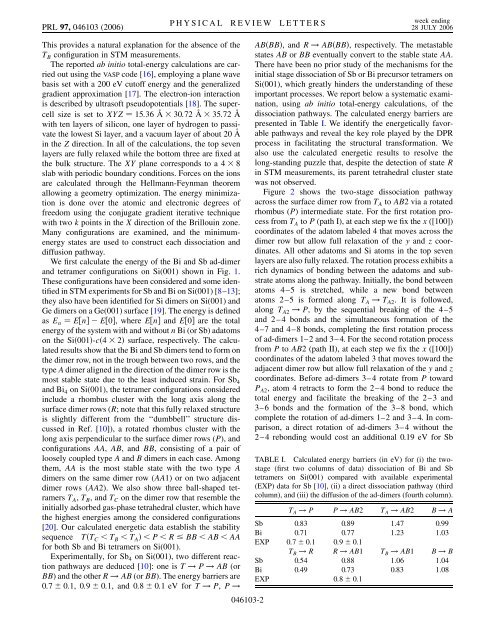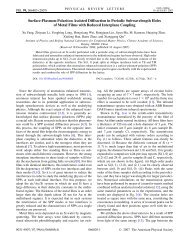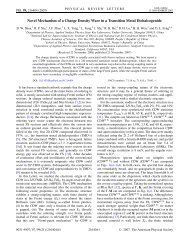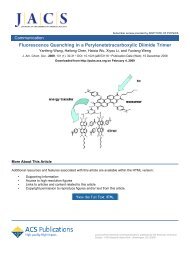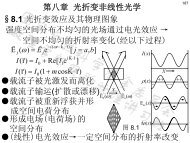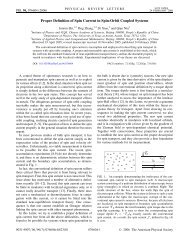Two-Stage Rotation Mechanism for Group-V Precursor Dissociation ...
Two-Stage Rotation Mechanism for Group-V Precursor Dissociation ...
Two-Stage Rotation Mechanism for Group-V Precursor Dissociation ...
You also want an ePaper? Increase the reach of your titles
YUMPU automatically turns print PDFs into web optimized ePapers that Google loves.
PRL 97, 046103 (2006)<br />
This provides a natural explanation <strong>for</strong> the absence of the<br />
T B configuration in STM measurements.<br />
The reported ab initio total-energy calculations are carried<br />
out using the VASP code [16], employing a plane wave<br />
basis set with a 200 eV cutoff energy and the generalized<br />
gradient approximation [17]. The electron-ion interaction<br />
is described by ultrasoft pseudopotentials [18]. The supercell<br />
size is set to XYZ 15:36 A 30:72 A 35:72 A<br />
with ten layers of silicon, one layer of hydrogen to passivate<br />
the lowest Si layer, and a vacuum layer of about 20 A˚<br />
in the Z direction. In all of the calculations, the top seven<br />
layers are fully relaxed while the bottom three are fixed at<br />
the bulk structure. The XY plane corresponds to a 4 8<br />
slab with periodic boundary conditions. Forces on the ions<br />
are calculated through the Hellmann-Feynman theorem<br />
allowing a geometry optimization. The energy minimization<br />
is done over the atomic and electronic degrees of<br />
freedom using the conjugate gradient iterative technique<br />
with two k points in the X direction of the Brillouin zone.<br />
Many configurations are examined, and the minimumenergy<br />
states are used to construct each dissociation and<br />
diffusion pathway.<br />
We first calculate the energy of the Bi and Sb ad-dimer<br />
and tetramer configurations on Si(001) shown in Fig. 1.<br />
These configurations have been considered and some identified<br />
in STM experiments <strong>for</strong> Sb and Bi on Si(001) [8–13];<br />
they also have been identified <strong>for</strong> Si dimers on Si(001) and<br />
Ge dimers on a Ge(001) surface [19]. The energy is defined<br />
as E n E n E 0 , where E n and E 0 are the total<br />
energy of the system with and without n Bi (or Sb) adatoms<br />
on the Si 001 -c 4 2 surface, respectively. The calculated<br />
results show that the Bi and Sb dimers tend to <strong>for</strong>m on<br />
the dimer row, not in the trough between two rows, and the<br />
type A dimer aligned in the direction of the dimer row is the<br />
most stable state due to the least induced strain. For Sb 4<br />
and Bi 4 on Si(001), the tetramer configurations considered<br />
include a rhombus cluster with the long axis along the<br />
surface dimer rows (R; note that this fully relaxed structure<br />
is slightly different from the ‘‘dumbbell’’ structure discussed<br />
in Ref. [10]), a rotated rhombus cluster with the<br />
long axis perpendicular to the surface dimer rows (P), and<br />
configurations AA, AB, and BB, consisting of a pair of<br />
loosely coupled type A and B dimers in each case. Among<br />
them, AA is the most stable state with the two type A<br />
dimers on the same dimer row (AA1) or on two adjacent<br />
dimer rows (AA2). We also show three ball-shaped tetramers<br />
T A, T B, and T C on the dimer row that resemble the<br />
initially adsorbed gas-phase tetrahedral cluster, which have<br />
the highest energies among the considered configurations<br />
[20]. Our calculated energetic data establish the stability<br />
sequence T T C


